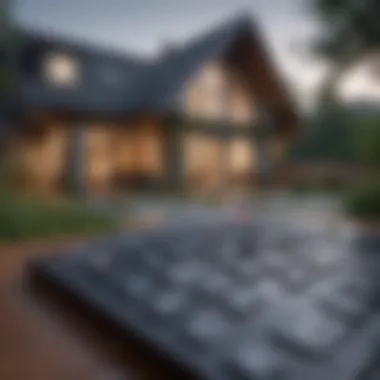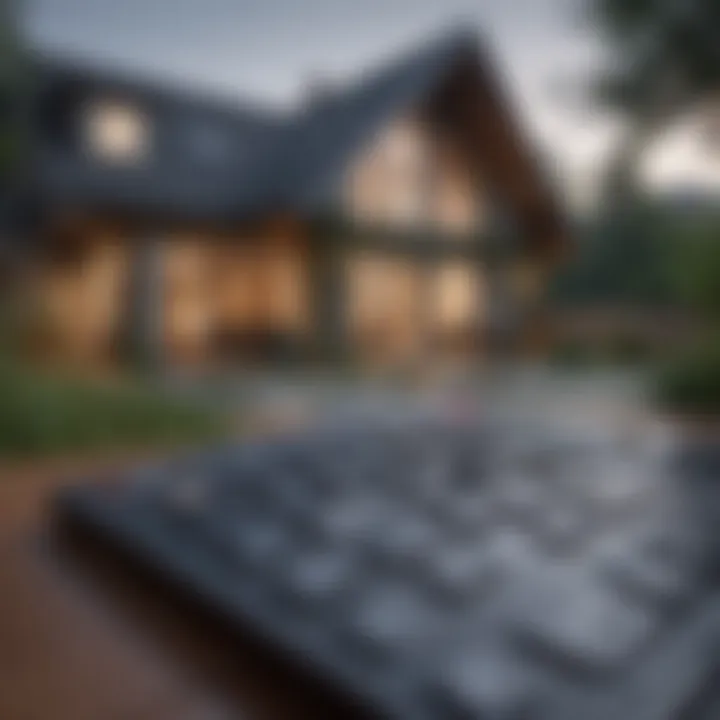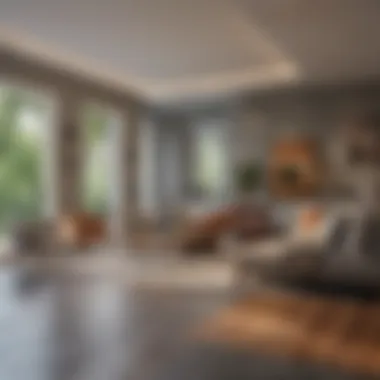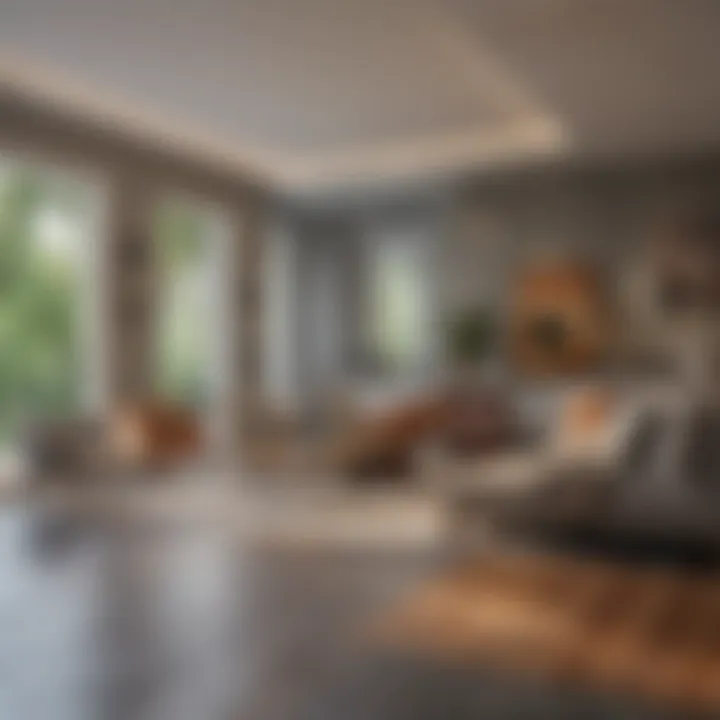Calculating the Square Footage of a House: A Comprehensive Guide


Intro
Understanding the square footage of a house is a critical component in real estate. It plays a significant role for homeowners, potential buyers, and design enthusiasts. Accurately measuring this space ensures that the details of the property can be comprehended clearly. Moreover, the square footage has implications for value assessments, design planning, and overall decision-making in real estate transactions.
This guide delves into measuring square footage accurately, exploring methods and relevant measurements. It will also discuss the importance of this measurement in the broader context of home design and purchase decisions. By the end of the article, readers will be equipped with practical knowledge, empowering them to navigate their property ventures with confidence.
Featured Homes
When exploring square footage and its implications, we also touch upon the homes where these measurements become significant. The architecture and design themes prevalent within featured homes can influence how square footage is perceived and valued.
Architectural Highlights
Different architectural styles contribute unique characteristics to homes, which can affect their square footage. For instance, a craftsman-style home may prioritize a horizontal layout, leading to larger square footage dedicated to outdoor porches and open-plan living. In contrast, a modernist design might emphasize verticality and minimalism, potentially decreasing overall square footage while maximizing utility.
Certain architectural features can also add complexity to calculating square footage. Spaces like alcoves or vaulted ceilings may require special consideration to ensure accuracy in measurements.
Interior Design Themes
Understanding how interior design interacts with square footage is essential. For instance, how spaces are arranged can significantly impact functionality, leading to a more practical or luxurious use of square footage.
- Open Concept Layouts: These designs make spaces feel larger and often use square footage efficiently, allowing for social interactions and ease of movement.
- Multifunctional Spaces: As lifestyles evolve, homes often incorporate rooms that serve multiple purposes. This can sometimes be deceptive as these multifunctional spaces must be measured accurately to maintain clarity on square footage.
The interplay between architecture and interior design shapes the essence of a home. Clarity in square footage allows homeowners to design meaningful spaces that reflect their needs and preferences.
Location Spotlights
The geographic context of a home can also influence square footage considerations. Different regions feature unique architectural styles and layouts that can affect home value and functionality.
Cultural Significance
Cultural influences can guide design and square footage allocation within homes. In urban areas, for example, space is often at a premium, leading to more compact living solutions. In contrast, suburban and rural settings may favor larger homes, unencumbered by these spatial constraints. By understanding cultural significance, homeowners can appreciate how their square footage relates to lifestyle trends and community dynamics.
Natural Wonders
Lastly, the surrounding landscape and environmental features can also dictate how square footage is conceptualized and utilized. Homes near mountains or lakes may highlight outdoor living spaces, effectively enhancing perceived square footage through terraces and outdoor rooms. This aspect becomes vital when considering designs that reflect their natural environment.
In summary, the square footage of a house holds substantial importance in real estate. The relationship between architectural details, interior design, cultural significance, and geographical context shapes how this measurement is understood and valued. This comprehensive guide aims to clarify the process of calculating square footage while also contextualizing its significance within the broader landscape of homeownership and design.
Prelims to Square Footage
Understanding square footage is crucial for anyone involved in real estate, home buying, or interior design. It serves as a fundamental aspect of property evaluation and also plays an essential role in how spaces are organized and utilized. Knowing the square footage of a house can influence purchasing decisions, affect property listings, and impact overall market value. This section will clarify what square footage means and why it remains so significant in various contexts.
Definition of Square Footage
Square footage refers to the total area of a given space, measured in square feet. It is calculated by multiplying the length of a space by its width. For example, if a living room measures 10 feet by 15 feet, its square footage would be 150 square feet (10 x 15 = 150). This straightforward calculation provides a valuable metric for comparing different homes or rooms, assisting buyers in determining how well a space meets their needs.
Importance of Accurate Measurements
Accurate measurements are vital in ensuring that square footage calculations reflect the true size of a property. Inaccuracies can result in misunderstandings about space available, which could lead to frustration for buyers and sellers alike. A precise calculation supports informed decision-making based on realistic expectations. It also avoids conflicts that can arise during real estate transactions, such as differences in perception regarding a property's value or function. Moreover, accurate measurements help in designing spaces effectively, ensuring that every square foot is utilized to its fullest potential.
"A precise understanding of square footage not only informs buyers but also elevates the overall experience of interacting with a property."
In summary, comprehending square footage goes beyond mere numbers. It contributes to more profound interactions with space, impacts market value, and fosters informed choices, making it an essential topic for homeowners and real estate professionals.
Methods for Calculating Square Footage
Understanding the methods for calculating square footage is crucial in an accurate assessment of a home. Different approaches can yield varying results, which makes knowing the right process essential for real estate enthusiasts and homebuyers. Knowing how to measure space can influence purchasing decisions and valuations, with potential implications on investment returns.
In this section, we will explore three primary methods for calculating square footage: using simple measurements, incorporating architectural features, and applying mathematical formulas. Each method has its own advantages and considerations, ensuring that a comprehensive understanding is achieved.
Using Simple Measurements
Simple measurements involve the most straightforward way of calculating square footage. Typically, this means taking the length and width of a room and multiplying these two dimensions. For instance, if a living room measures 15 feet in length and 10 feet in width, the calculation would be: 15 x 10 = 150 square feet.
This method works best for rectangular or square-shaped rooms. There are a few key steps to effectively apply this technique:


- Get a Measuring Tape: Use a standard measuring tape to ensure accuracy.
- Measure Length and Width: Carefully measure each room's length and width, ideally from baseboard to baseboard.
- Multiply: Once you have the dimensions, simply multiply them.
While this method is relatively easy, it may not account for irregularities in room shapes or measurements. Users should take care to ensure they capture all necessary measurements, relying on simple arithmetic to arrive at an accurate assessment of square footage.
Incorporating Architectural Features
Many homes feature unique architectural elements that can complicate square footage calculations. These include alcoves, built-ins, and non-standard shapes. In such cases, it is important to adjust traditional measurement methods to capture these aspects accurately. A room with bumps, recesses, or outcroppings can affect the overall square footage significantly.
To incorporate these features, consider the following points:
- Breakdown Complex Shapes: Divide rooms into smaller, manageable sections. For example, if a room has a protruding corner, measure the rectangular sections separately before adding them together.
- Account for Architectural Details: Identify and measure any built-ins or architectural features that impact space, treating them as part of the overall square footage.
- Sketch It Out: Create a rough sketch to visualize the space. This can aid in understanding how best to combine measurements.
Making these adjustments will yield a more precise result. Identifying all features ensures that no valuable space is overlooked.
Applying Mathematical Formulas
Mathematical formulas can provide a more advanced method of calculating square footage, especially in non-standard shapes. This approach is particularly useful for areas that are not simply rectangular. Various formulas exist, depending on the shape being measured:
- Rectangle: Length x Width
- Triangle: (Base x Height) / 2
- Circle: π x (Radius)^2
Using formulas allows for a highly precise calculation. Here are some guidelines:
- Identify the Shape: Determine the geometric shape of the area being measured.
- Use Accurate Measurements: Taking precise measurements ensures that the formulas yield correct results.
- Be Aware of Units: Ensure that all measurements are in the same units before applying the formulas.
Mathematical calculations add a layer of complexity but can enhance accuracy significantly. This method is well suited for discerning homeowners or buyers who seek detailed understanding in their space assessments.
"A meticulous approach to measuring will save you from costly miscalculations, whether you are buying or designing a home."
Step-by-Step Guide to Measuring a Home
Measuring a home accurately is a fundamental process for anyone looking to understand the dimensions and layout of a living space. This comprehensive guide simplifies that process into actionable steps that ensure precise calculations. Accurate measurements contribute significantly to home evaluations, renovations, and design endeavors. Having a clear understanding of how to measure not only aids in real estate transactions but also enhances the overall functionality of the space.
Gathering Necessary Tools
To start on the right foot, it’s crucial to gather all the necessary tools. The following items are essential for effective measurement:
- Measuring tape: A long measuring tape, preferably twenty-five feet or longer, is essential for larger spaces.
- Laser distance measurer: This tool offers quick and often more accurate readings, especially in hard-to-reach areas.
- Calculator: A simple calculator will help in performing multiplication for finding the area of various shapes.
- Notebook and pen: Recording your findings is critical to avoid confusion later.
Having these tools at hand not only streamlines the measurement process but also ensures that you do not miss critical data during your calculations.
Measuring Each Room
Once you have your tools ready, the next step is to measure each room. Start with the larger spaces, as these often set the tone for the rest of the home. Here is how you can do it:
- Measure the length and width: Measure each wall with your tape or laser tool. Be sure to measure from corner to corner for maximum accuracy.
- Note any irregularities: If a room has alcoves or irregular shapes, make careful notes. For non-rectangular spaces, consider breaking down the area into smaller, measurable sections.
- Record dimensions: Write down all measurements in your notebook. It’s good practice to label each room; this will make calculations clearer.
Taking time to measure precisely is important. Rushing through this step can lead to errors that potentially affect the total square footage calculations.
Calculating Total Square Footage
After measuring each room, the final step is to calculate the total square footage of the home.
- Calculate area of each room: For standard rectangular rooms, multiply the length by the width. For example, if a room is 12 feet by 15 feet, the area is 180 square feet.
- Add all areas together: Once you have all the areas calculated, sum them to get the total square footage of the home.
- Account for additional spaces: Include hallways, closets, and any other usable spaces in your calculations.
Here is a quick example for clarity:
If you measured two rooms—Room A (12x15 = 180 sq ft) and Room B (10x12 = 120 sq ft)
Total = 180 + 120 = 300 sq ft
Make sure to double-check your multiplication and addition to avoid any potential mistakes. These careful calculations will ultimately guide decisions regarding real estate assessments, renovations, or even when glaring flaws in layouts arise.
Accurate measurement is the backbone of effective home planning and design. Failing to measure correctly can lead to costly renovations or devaluations in real estate decisions.
Considerations for Different Levels
When it comes to calculating square footage, homes with multiple levels present unique challenges. High ceilings, varying shapes and sizes, and different flooring types can complicate the process. Without proper attention to detail, inaccuracies can arise, leading to significant discrepancies in the reported area. It is vital to consider how these factors alter measurements.
Calculating Square Footage for Multi-Story Homes
For homes with more than one story, the calculation needs to include each level truthfully. A common mistake is to simply add the square footage from each level without accounting for any specific characteristics or misalignments. Each floor may have different dimensions due to architectural design, and certain spaces may not fit into a standard rectangular calculation. When measuring, it is helpful to take exact measurements of each room on each floor. Be precise and label each room as you go. Don't forget to document the area of staircases, as these also contribute to the overall square footage.


Dealing with Sloped Ceilings
Sloped ceilings add complexity to square footage calculations. They affect the usable area of a room, and often, people overlook them while measuring. The standard approach is to calculate the area of the floor, but reduce the effective area based on how much vertical space is available. For example, many guidelines state that any portion of a room with a ceiling height less than five feet does not count towards the overall square footage. This aspect can be crucial, especially in spaces like attics or lofts where slopes are common. Be clear on how you intend to define the measured areas for accurate reporting.
Including Basements and Attics
Basements and attics often require special consideration. Basements can be tricky since they may not always be finished or used as living spaces. If a basement does have residential features like windows or proper insulation, it should typically be counted in the square footage. However, unfinished basements may not count depending on local guidelines or buyer expectations. Attics present a similar situation. Many attics are not utilized as livable spaces, but if they meet the criteria of having sufficient height and accessibility, they can indeed be counted. Always check local regulations or standards to ensure compliance when measuring these areas.
Accurate square footage calculations in multi-level homes, dealing with sloping ceilings, and including specific areas like basements and attics can save homeowners from future challenges in property value assessments and real estate transactions.
Common Mistakes to Avoid
Calculating square footage can appear straightforward, yet there are significant mistakes homeowners and buyers often make. Recognizing these errors is critical to ensure accurate measurements. Being aware of these common pitfalls enhances the decision-making process in real estate transactions and home design.
Mistakes in measuring can lead to misunderstandings about the true value of a property, affecting everything from pricing strategies to renovations. This section aims to clarify two prevalent errors: ignoring non-living spaces and underestimating rooms with irregular shapes.
Ignoring Non-Living Spaces
One prevalent mistake in measuring square footage is the oversight of non-living spaces. Many individuals focus solely on the usable living areas of a home. Areas such as hallways, closets, and utility rooms are often neglected. It is essential to account for these spaces as they contribute to the overall square footage value.
You might think these areas are minor. However, including these measurements can elevate the total square footage significantly.
- Example areas:
- Hallways and corridors
- Closets
- Laundry rooms
By including all areas, including non-living spaces, you can accurately reflect the size of your home. This consideration is particularly vital for property listings. A larger square footage can enhance perceptions of value and attract prospective buyers.
Underestimating Rooms with Irregular Shapes
Another common error is underestimating rooms with irregular shapes. Many people ignore the complications these spaces can introduce into the overall calculation. If a room does not conform to standard rectangular dimensions, calculating its area requires more effort.
It is important to remember that irregular shapes can often lead to inaccuracies in square footage if measured carelessly. For accurate calculations, follow these steps:
- Divide the room into sections: Break down irregular rooms into smaller, manageable shapes, such as rectangles or triangles.
- Calculate each section’s area: Use appropriate formulas for each basic shape. This method allows for precise measurement and avoids error.
- Sum the areas: Combine the calculated areas to obtain the total square footage for the room.
By taking the time to consider irregular shapes, you ensure all spaces are included accurately in your total square footage calculation.
Always strive for accuracy. Small oversights can lead to significant discrepancies in property value.
Considering these common errors leads to improved precision in square footage calculations, ultimately benefiting homeowners and real estate professionals alike.
Tools and Technology for Square Footage Calculation
Calculating square footage can be a detailed task. Fortunately, various tools and technologies simplify the process. Having the right devices not only enhances accuracy but also improves efficiency. This section will cover essential instruments and digital solutions that are crucial for effective square footage measurement.
Measuring Tape and Standard Calculators
Measuring tape is a fundamental tool for anyone measuring square footage. It is portable and easy to use. Typically, a retractable measuring tape can provide accurate dimensions of rooms. For best results, ensure to select a measuring tape that has clear markings and a sturdy build.
A standard calculator becomes necessary once the measurements are taken. It helps in performing basic calculations. For instance, multiply the length by the width to get the total square footage. Having a reliable calculator nearby can save time and help avoid miscalculations.
Software and Apps
With advancements in technology, many homeowners now turn to software and applications. Some apps are designed specifically for measuring square footage. These tools allow users to input dimensions from their measuring tape or even use built-in camera functions to scan rooms.
Common applications available include RoomScan Pro and MagicPlan. These apps often provide features such as storing designs and sharing them with others. They are particularly useful for those managing a renovation or exploring home design options. Adopting these technologies can assist with accuracy as well as improve the organization of measurements.
Professional Services
Engaging professional services can be beneficial in certain situations. When square footage calculations become complex—such as in larger homes or commercial properties—hiring experts can provide peace of mind. Surveyors or appraisers take into account intricate design elements when determining your home's square footage.
Using professionals reduces the risk of overlooking important factors like closets, alcoves, or unusual wall shapes. It is also helpful in situations where precise documentation is needed for real estate transactions. In some cases, the cost of hiring professionals is worthwhile given the accuracy they offer.
In sum, the tools and technologies discussed here present distinct benefits for calculating square footage accurately. Whether through simple tools like measuring tapes, advanced apps, or professional services, ensuring precision in measurement is of utmost importance.


Square Footage and Real Estate Value
Understanding how square footage relates to real estate value is crucial for anyone involved in the buying or selling process. The square footage of a house is not only relevant for assessing the size of a property but also plays a significant role in determining its market value. Real estate agents, buyers, and sellers all rely on square footage as a key metric. It helps set expectations and drives pricing strategies in the competitive real estate market.
When assessing a property's value, it's vital to recognize that square footage can influence buyer perception. A larger square footage usually indicates more living space, which people value, especially families and those who work from home. However, it's important to note that not all square footage is equal. The layout and how the space is used can also greatly affect value.
How Square Footage Affects Property Listings
In property listings, square footage serves as a fundamental piece of information. Listings that clearly state the exact square footage attract more attention than those that don't. Buyers use square footage as a principal factor in comparing different properties. If two homes are quite similar in price but one has significantly larger square footage, potential buyers might favor that larger home without hesitation.
Moreover, real estate listings often categorize properties by square footage ranges. These ranges can impact search results, filtering out homes that do not meet certain size criteria. A well-defined listing can therefore reach a larger, targeted audience.
When composing a property listing, agents typically emphasize square footage in the following ways:
- Clear Display: Prominently displaying the square footage at the top of the listing gives potential buyers immediate access to this critical measure.
- Comparative Analysis: Including a comparison of square footage with similar homes in the area can illustrate value.
- Highlighting Usable Space: Focus on usable square footage instead of just total square footage. For example, including finished basements and attics with relevant dimensions can make listings more attractive.
Understanding Price Per Square Foot
Price per square foot is another important metric in real estate valuation. This figure is calculated by dividing the home's price by its square footage. While it serves as a helpful tool for assessing value, it must be interpreted carefully. Different areas can have drastically different average prices per square foot based on demand, amenities, and other factors.
To accurately gauge any property's value using price per square foot, one should consider:
- Local Market Trends: This includes analyzing recent sales in the vicinity since prices can fluctuate based on neighborhood performance.
- Property Condition: Homes that require significant repairs or renovations may yield lower price per square foot, even with larger square footage.
- Amenities: Features such as pools, garages, and updated kitchens can substantially impact the price per square foot. Buyers expect to pay a premium for homes that offer more than just space.
Understanding both square footage and price per square foot creates a clearer picture when navigating real estate decisions. Both elements contribute considerably towards establishing market trends and ensuring informed choices.
"Square footage is more than just numbers; it's a critical aspect of understanding your home's value."
By focusing on the square footage of a house and translating that into tangible real estate value, potential buyers and sellers can make more informed decisions. Emphasizing accurate measurements and contextual understanding of the market is essential for successful real estate transactions.
Square Footage in Home Design
Understanding square footage is fundamental in the realm of home design. The amount of space within a home dictates not only how it looks but also how functional it can be. Every home has unique aspects that require careful consideration regarding space use and layout. In this section, we will delve into why square footage plays a crucial role in designing living environments, the benefits of optimized layouts, and specific considerations designers should keep in mind.
Designing for Functionality
Functionality is often the driving force behind effective home design. A well thought out layout can dramatically affect how a space is used. Homeowners often desire an environment that promotes efficiency and convenience. For this reason, knowing the correct square footage of each area is key.
Key aspects to consider include:
- Room Configuration: Room size influences which furnishings fit well. Accurate square footage ensures that spaces are neither overly cramped nor excessively empty.
- Flow between Spaces: An ideal design promotes ease of movement. Knowing dimensions helps in determining the best flow between rooms.
- Utilization of Corners and Nooks: Spaces often go underutilized due to incorrect assumptions about their size. Assessing square footage can reveal potential for transforming these areas into useful spots.
Ultimately, thoughtful attention to square footage allows designers to create spaces that are not only good-looking but are also very practical.
Optimizing Small Spaces
Small spaces present unique challenges but also offer opportunities for innovation. Designers must ensure every inch counts. Designing for small areas often requires creative solutions to utilize the square footage effectively.
Some strategies include:
- Multi-Functional Furniture: Pieces that serve dual purposes can help maximize utility. For example, a sofa bed or a coffee table that opens for storage can transform the use of space.
- Open Layout Concepts: Eliminating unnecessary walls can create an illusion of more space. An open design helps improve natural light flow as well as visibility within a home.
- Vertical Space Usage: Taking advantage of vertical surfaces for both storage and decor can help minimize clutter. Shelves that go up to the ceiling not only provide more storage but also draw the eye upward.
Whether designing a compact apartment or a tiny house, careful planning based on accurate square footage will ensure no area is squandered. As such, understanding how to measure and apply square footage considerations is indispensable for achieving effective home design.
Culmination
In this section, the focus is on the significance of understanding square footage calculations. Knowing how to accurately measure square footage is not just a matter of protocol; it plays a pivotal role in many aspects of home ownership and real estate transactions. For homebuyers, an accurate grasp of square footage ensures they are making informed decisions regarding property value. In terms of home design, architects and designers rely on these measurements to create functional and aesthetically pleasing spaces.
The benefits of precise square footage calculations are far-reaching. They aid in appraisals and assist in estimating renovation costs, which can significantly impact investment decisions. Moreover, accurate measurements can prevent conflicts during property transactions by establishing clear boundaries of living space.
Recap of Key Points
- Importance of Square Footage: It impacts purchasing decisions and property listings, serving as a metric for real estate value.
- Measurement Techniques: Various methods, tools, and considerations should be considered to ensure accuracy.
- Common Mistakes: Recognizing pitfalls, like excluding spaces and underestimating irregular rooms, can enhance measurement precision.
- Technological Tools: Advances in software and apps can streamline the calculation process, providing ease and accuracy.
This review encapsulates the critical elements discussed throughout the article, highlighting the necessity of precise square footage calculations.
Encouragement for Accurate Measurement Practices
Accurate measurement practices are essential for any homeowner, real estate agent, or designer. Regularly verifying measurements can foster confidence during transactions. Individuals should adopt systematic procedures, which include:
- Double-Checking Measurements: Always take measurements twice to ensure accuracy.
- Using Reliable Tools: Invest in quality measuring devices and software that can help facilitate precise calculations.
- Continuous Learning: Stay updated with the latest technology and methods in measurement practices to refine your skills.
By adopting diligent measurement practices, one can avoid costly mistakes and ensure a clearer understanding of a property's value. Precision in square footage calculations not only safeguards one’s financial interests but also enriches the overall experience of property management and design.







